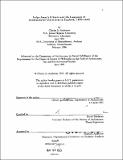| dc.contributor.advisor | David Friedman. | en_US |
| dc.contributor.author | Anderson, Christy Jo | en_US |
| dc.date.accessioned | 2005-08-15T21:55:42Z | |
| dc.date.available | 2005-08-15T21:55:42Z | |
| dc.date.copyright | 1993 | en_US |
| dc.date.issued | 1993 | en_US |
| dc.identifier.uri | http://hdl.handle.net/1721.1/12670 | |
| dc.description | Thesis (Ph. D.)--Massachusetts Institute of Technology, Dept. of Architecture and Planning, 1993. | en_US |
| dc.description | Vita. | en_US |
| dc.description | Includes bibliographical references (v. 2, leaves 330-351). | en_US |
| dc.description.abstract | Inigo Jones's collection of books is a unique and early survival of an architect's annotated library. The combination of standard sixteenth century Italian and French editions of classics, mathematical and scientific treatises, and specialized architectural books, comprised the library of a professional whose approach to his field was based on an understanding of practical humanism and the study of antique precedent. The library is the starting point for an investigation of the relationship of humanist learning and the creation in England of a classical architectural vocabulary. The forty~s ix books record in Jones's marginal annotations to the text and plates his interpretation of continental architecture and textual exegesis. For Jones, books were a crucial resource for the study of classical architecture as practiced in continental Europe; and necessary for an understanding of the intellectual precepts inherent in that architectural vocabulary. Jones's architectural self~education reflected and repeated the desire by patrons for a visible document of their humanist learning and aspirations. From the evidence of the marginal annotations by Jones, I discuss three central themes of the shift in architectural style in England during the period 1580 to 1640: the role of reading as an essential professional skill for the architect and its mnemonic function in design method; the use and significance of the orders as a system for representing ideas of personal and public decorum and learning; and Jones's use of the methods and resources of English antiquarians in his study of ancient architectural precedent. Each of these themes are located within the cultural and intellectual history of Renaissance England. The descriptive language created for architecture, and the images used to encourage its study, was the language of education and classical learning, and specifically, the language of books. The appropriation by Jones and his patrons of the Vitruvian notion of decorum- the distinction between the exterior of a building and its internal distribution- formed a central tenet of English classicism, in Jones's terms the creation of an architecture "masculine and unaffected." The library of Inigo Jones represented one of the architect's essential professional tools, a repository of ideas and models which could serve as an ever present resource and comparable to other professional collections created by those seeking advancement within the late Tudor and early Stuart court. An annotated and descriptive bibliography of the surviving volumes, and further likely titles, attests to Jones's wide~ranging interests and design acumen. | en_US |
| dc.description.statementofresponsibility | by Christy Jo Anderson. | en_US |
| dc.format.extent | 2 v. (437 leaves) | en_US |
| dc.format.extent | 39917147 bytes | |
| dc.format.extent | 39916904 bytes | |
| dc.format.mimetype | application/pdf | |
| dc.format.mimetype | application/pdf | |
| dc.language.iso | eng | en_US |
| dc.publisher | Massachusetts Institute of Technology | en_US |
| dc.rights | M.I.T. theses are protected by copyright. They may be viewed from this source for any purpose, but reproduction or distribution in any format is prohibited without written permission. See provided URL for inquiries about permission. | en_US |
| dc.rights.uri | http://dspace.mit.edu/handle/1721.1/7582 | |
| dc.subject | Architecture | en_US |
| dc.subject | Urban Studies and Planning | en_US |
| dc.subject.lcsh | Jones, Inigo, 1573-1652. | en_US |
| dc.title | Inigo Jones's library and the language of architectural classicism in England, 1580-1640 | en_US |
| dc.type | Thesis | en_US |
| dc.description.degree | Ph.D. | en_US |
| dc.contributor.department | Massachusetts Institute of Technology. Department of Architecture | |
| dc.contributor.department | Massachusetts Institute of Technology. Department of Urban Studies and Planning | |
| dc.identifier.oclc | 28629122 | en_US |
